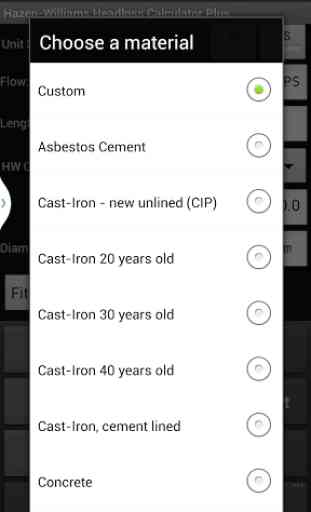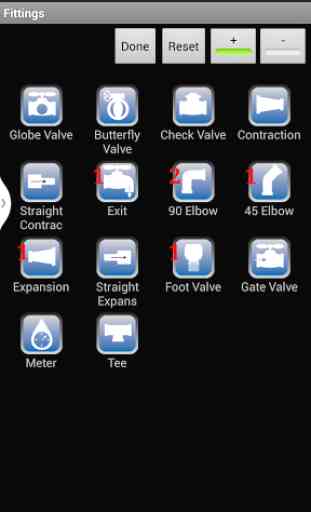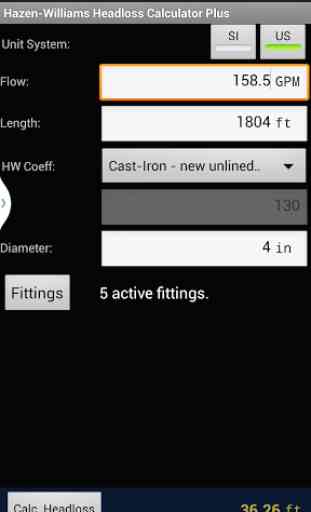Pipe Headloss Calculator Plus
Pipe Headloss Calculator Plus app can be used for estimating frictional head loss in pipes. This app version compared to the free includes fittings and valves calculation and selection of the pipe material.
The total pressure loss in the system results from the combined losses due to friction in length of pipe and friction losses due to valves, fittings, and other components. The first are "major losses" associated with energy loss per length of pipe, and seconds are "minor losses" associated with bends, fittings, valves, etc.
The factors that determine friction losses in pipe are:
The velocity of the water: As velocity increases, pressure losses increase. Velocity is directly related to flow rate.
The size (inside diameter) of the pipe: Smaller pipe causes a greater proportion of the water to be in contact with the pipe, which creates friction. Pipe size also affects velocity. Given a constant flow rate, decreasing pipe size increases the water’s velocity, which increases friction.
The roughness of the inside of the pipe: Pipe inside wall roughness is rated by a C factor, which can be selected depending on material of pipe. The lower the C value, the rougher the inside and the more pressure loss due to friction.
The length of the pipe: The friction losses are cumulative as the water travels through the length of pipe. The greater the distance, the greater the friction losses will be.
The friction losses for, elbows, and tees can also be selected. The friction losses in fittings such as couplings, elbows, tees, valves and other elements play a role. Friction loss from these components must be taken into account when calculating friction losses for each section of pipe.
Calculation of friction factor is based on the Hazen-Williams equation. Local resistances factor K for valves and some fittings (tees, elbows, pipes contraction and enlargement), can be found in app itself.
Example: Calculate pressure losses in a pumping of 10 l / s. The diameter of the suction and discharge is 100 mm or 4 ". We have the following items on the Suction: 1 foot valve, 1 gate valve , 1 elbow 90, 1 contraction to 3" to entering the pump. In the discharge we have: 1 expansion, 2 elbow 90, a check valve, 1 gate valve. The total pipe length is 10 meters in diameter of 100 mm. Must be calculated the pressure losses for the given flow.
The total pressure loss in the system results from the combined losses due to friction in length of pipe and friction losses due to valves, fittings, and other components. The first are "major losses" associated with energy loss per length of pipe, and seconds are "minor losses" associated with bends, fittings, valves, etc.
The factors that determine friction losses in pipe are:
The velocity of the water: As velocity increases, pressure losses increase. Velocity is directly related to flow rate.
The size (inside diameter) of the pipe: Smaller pipe causes a greater proportion of the water to be in contact with the pipe, which creates friction. Pipe size also affects velocity. Given a constant flow rate, decreasing pipe size increases the water’s velocity, which increases friction.
The roughness of the inside of the pipe: Pipe inside wall roughness is rated by a C factor, which can be selected depending on material of pipe. The lower the C value, the rougher the inside and the more pressure loss due to friction.
The length of the pipe: The friction losses are cumulative as the water travels through the length of pipe. The greater the distance, the greater the friction losses will be.
The friction losses for, elbows, and tees can also be selected. The friction losses in fittings such as couplings, elbows, tees, valves and other elements play a role. Friction loss from these components must be taken into account when calculating friction losses for each section of pipe.
Calculation of friction factor is based on the Hazen-Williams equation. Local resistances factor K for valves and some fittings (tees, elbows, pipes contraction and enlargement), can be found in app itself.
Example: Calculate pressure losses in a pumping of 10 l / s. The diameter of the suction and discharge is 100 mm or 4 ". We have the following items on the Suction: 1 foot valve, 1 gate valve , 1 elbow 90, 1 contraction to 3" to entering the pump. In the discharge we have: 1 expansion, 2 elbow 90, a check valve, 1 gate valve. The total pipe length is 10 meters in diameter of 100 mm. Must be calculated the pressure losses for the given flow.
Category : Tools

Related searches
Reviews (6)
Mic. P.
Mar 10, 2016
Calcs look correct, thank you for the app.
Yan. K.
Apr 4, 2019
good application
A. G. u.
Oct 30, 2012
It would be good that it included all the ID real pipe sizes for given nominal Pipe Sizes, otherwise you still need to go to check for that information somewhere else. It does not save me a trip to my computer anyway, unless I create a separate file with all that info. Also, please include elevation changes.
L.. J.
Sep 6, 2016
Dose not allow conversion from metric to standard or back. Very limited program. Warning you can do better.
A. G. u.
Oct 26, 2012
Would be nice to have solenoid valves, or a blank slot to enter other misc parts and a value





Fitting resistance not even near accurate on cast pipes. Have tried several types of elbows and can't find any that make sense for the numbers given. However, if restriction is converted to length and added in the numbers test very well.